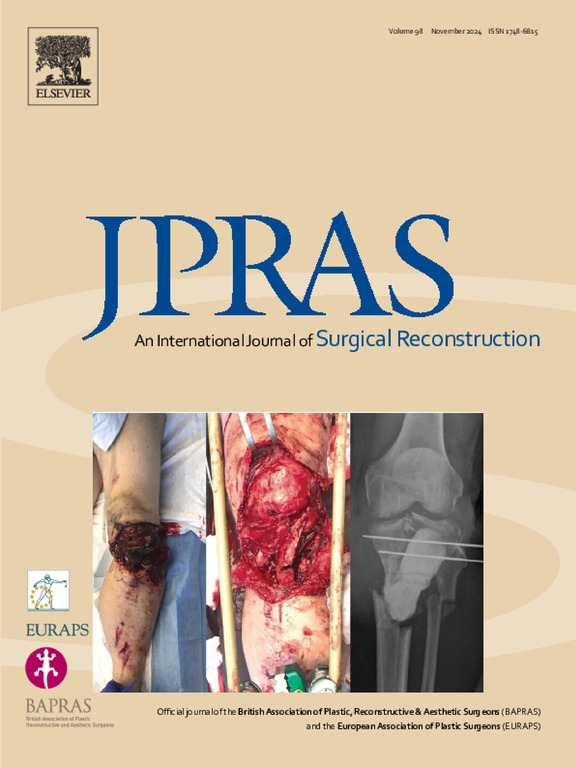Exoscope-assisted orbital fracture reduction surgery—Clinical assessment by surgeons: A retrospective cohort study
IF 2
3区 医学
Q2 SURGERY
Journal of Plastic Reconstructive and Aesthetic Surgery
Pub Date : 2025-04-07
DOI:10.1016/j.bjps.2025.04.007
引用次数: 0
Abstract
Background
Exoscope-assisted digital imaging allows continuous real-time visualization of the surgical site on a large 3D monitor. We evaluated its usefulness in orbital fracture reduction surgery, a procedure with a narrow and deep operative field that restricts direct visibility for the operating surgeon.
Methods
This retrospective cohort study included all patients who underwent orbital floor fracture reduction with an absorbable plate via a subciliary approach at our institution from January 2022 to December 2024. ORBEYE 3D exoscope system (Olympus, Tokyo, Japan) was used in all cases when available, as the device was shared among several departments in our institution. Surgeries performed with and without the ORBEYE exoscope were compared for the following preoperative variables: (i) years since the surgeon’s graduation and (ii) days from injury to surgery, and outcome variables including (iii) operative time, (iv) blood loss, and (v) absorbable plate size. Surgeons also completed a questionnaire regarding their experience with ORBEYE.
Results
Eleven patients underwent conventional surgery, and 10 underwent ORBEYE-assisted surgery. ORBEYE-assisted surgery resulted in a significantly shorter operative time, while no significant differences were observed in other preoperative or outcome variables. The involved surgeons reported reduced physical strain, particularly in the neck, as well as improved collaboration and education. Despite some disadvantages, all surgeons expressed a positive attitude toward continued ORBEYE use.
Conclusions
ORBEYE-assisted surgery offers significant advantages in orbital floor fracture reduction, including reduced operative time, improved ergonomics, and enhanced teamwork and education. Its drawbacks are relatively minor, and broader adoption in plastic surgery should be considered.
外窥镜辅助眶骨折复位手术-外科医生的临床评估:一项回顾性队列研究
显微镜辅助的数字成像可以在大型3D监视器上连续实时显示手术部位。我们评估了它在眶骨折复位手术中的实用性,这是一种窄而深的手术视野限制了手术医生的直接可见性的手术。方法:本回顾性队列研究纳入了所有于2022年1月至2024年12月在我院接受经睫骨下入路可吸收钢板眶底骨折复位的患者。ORBEYE 3D外窥镜系统(Olympus, Tokyo, Japan)在所有情况下都使用,因为该设备在我们机构的几个部门之间共享。比较使用ORBEYE外窥镜和不使用ORBEYE外窥镜进行的手术的以下术前变量:(i)外科医生毕业后的年份,(ii)从受伤到手术的天数,以及结果变量,包括(iii)手术时间,(iv)出血量,(v)可吸收钢板大小。外科医生还完成了一份关于他们使用ORBEYE经验的调查问卷。结果16例患者行常规手术,10例行orbeye辅助手术。orbeye辅助手术可显著缩短手术时间,而其他术前或结局变量无显著差异。参与手术的外科医生报告说,他们减轻了身体上的压力,尤其是颈部的压力,并改善了合作和教育。尽管存在一些缺点,但所有外科医生都对继续使用ORBEYE持积极态度。结论sorbeye辅助手术在眶底骨折复位中具有明显优势,包括缩短手术时间,改善人体工程学,加强团队合作和教育。它的缺点相对较小,应该考虑在整形手术中广泛采用。
本文章由计算机程序翻译,如有差异,请以英文原文为准。
求助全文
约1分钟内获得全文
求助全文
来源期刊
CiteScore
3.10
自引率
11.10%
发文量
578
审稿时长
3.5 months
期刊介绍:
JPRAS An International Journal of Surgical Reconstruction is one of the world''s leading international journals, covering all the reconstructive and aesthetic aspects of plastic surgery.
The journal presents the latest surgical procedures with audit and outcome studies of new and established techniques in plastic surgery including: cleft lip and palate and other heads and neck surgery, hand surgery, lower limb trauma, burns, skin cancer, breast surgery and aesthetic surgery.

 求助内容:
求助内容: 应助结果提醒方式:
应助结果提醒方式:


